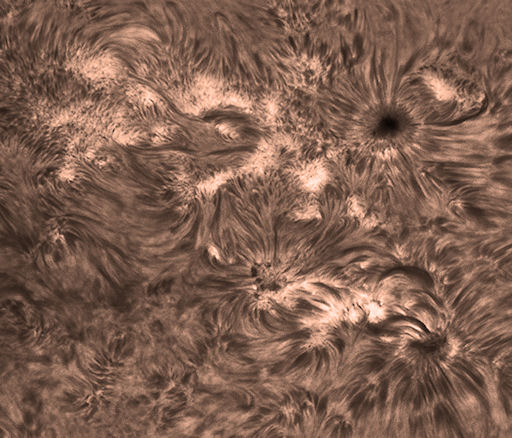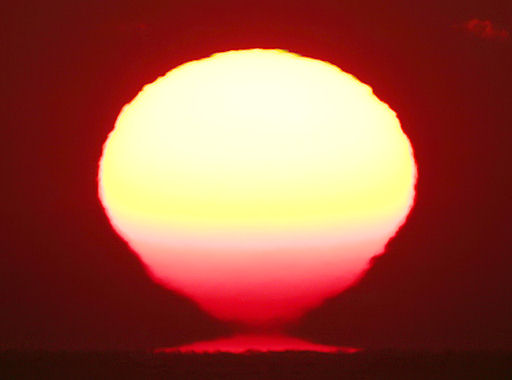Turn your cell phone into a field-tested satellite tracker. Works for Android and iPhone. | | |
DID YOU SEE THAT FIREBALL? Spaceweather.com is seeking reports of a possible fireball or other bright lights in the sky over North America on Jan. 18th around 4 am EST. The area of particular interest extends from Lake Michigan to southern parts of Ontario and upper New York state. Did you see anything? Submit your reports here.
SUNSPOT ACTIVITY: The biggest sunspots of the year are putting on a show for amateur astronomers. From his backyard observatory in Brazil, Rogerio Marcon photographed a maelstrom of hot gas swirling around the dark cores of AR1147-1149 on Jan. 22nd:

"I took the picture using a small refracting telescope and an H-alpha filter tuned to the red glow of solar hydrogen," explains Marcon.
Sunspot 1149 (the southern half of the complex) has a tangled magnetic field that harbors energy for strong flares. NOAA forecasters estimate a 10% chance of M-class eruptions during the next 24 hours. Readers with solar telescopes should continue to monitor the region for explosive developments.
more images: from Patrick Lécureuil of Mauroux, sud-west France; from Matthew Wastell of Brisbane, Australia; from Robert Arnold of Isle of Skye; from Stefano Sello of Pisa, Italy; from Strikis Iakovos of Athens, Greece; from Ron Cottrell of Oro Valley, Arizona; from Robert Spellman of Azusa, Ca; from Monika Landy-Gyebnar of Veszprem, Hungary
OMEGA SUNSET: "Last night's sunset was an amazing sight," reports Pete Lawrence from West Beach in Selsey, UK. "As the sun approached the horizon, the lower half of the solar disk extended downwards to touch an image of itself rising out of the waves." He took this picture of the phenomenon:

Jules Verne famously likened this kind of sunset to an Etruscan Vase. Others call it an "Omega sunset" because it resembles the Greek letter. Either way, it is caused by warm air overlying the sea surface, which refracts the rays of the setting sun to produce a mirage, as shown.
This is a good weekend to watch the sunset. Not only are mirages a possibility, but also you might observe a sunspot in the twilight. On Jan. 22nd, Martin McKenna witnessed this sunspot sunset from Maghera, Northern Ireland.
January 2011 Aurora Photo Gallery
[previous Januaries: 2010, 2009, 2008, 2007, 2005, 2004]
Solar Eclipse Photo Gallery
[NASA: Hinode Observes Annular Solar Eclipse]
Potentially Hazardous Asteroids (
PHAs) are space rocks larger than approximately 100m that can come closer to Earth than 0.05 AU. None of the known PHAs is on a collision course with our planet, although astronomers are finding
new ones all the time.
On January 23, 2011 there were 1184 potentially hazardous asteroids.
Notes: LD means "Lunar Distance." 1 LD = 384,401 km, the distance between Earth and the Moon. 1 LD also equals 0.00256 AU. MAG is the visual magnitude of the asteroid on the date of closest approach. | | The official U.S. government space weather bureau |
| | The first place to look for information about sundogs, pillars, rainbows and related phenomena. |
| | Researchers call it a "Hubble for the sun." SDO is the most advanced solar observatory ever. |
| | 3D views of the sun from NASA's Solar and Terrestrial Relations Observatory |
| | Realtime and archival images of the Sun from SOHO. |
| | from the NOAA Space Environment Center |
| | the underlying science of space weather |

